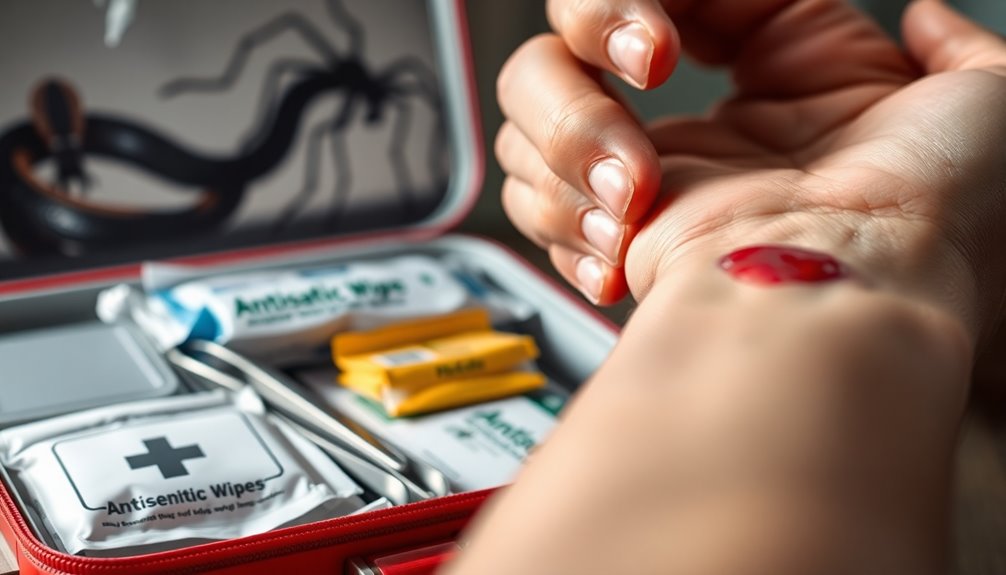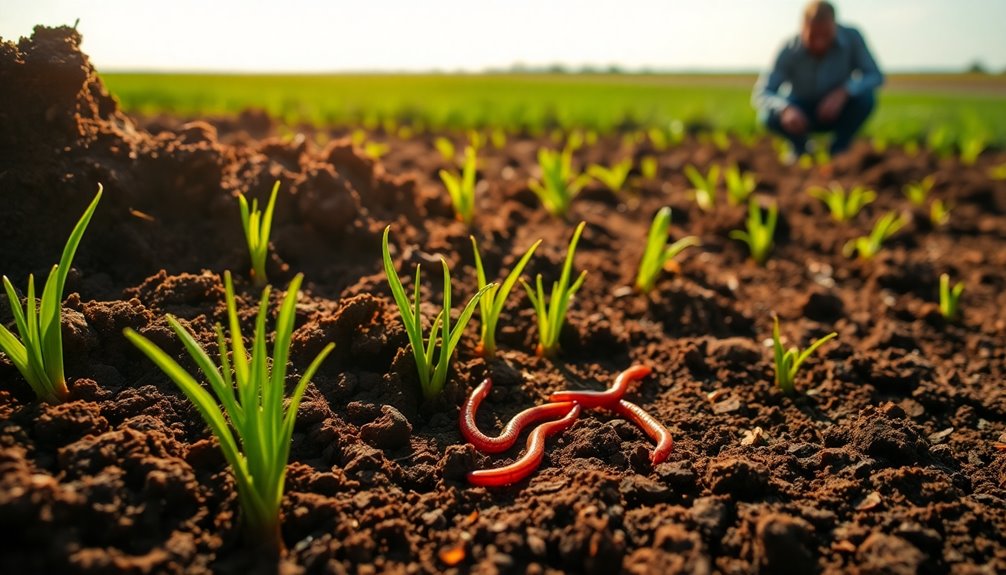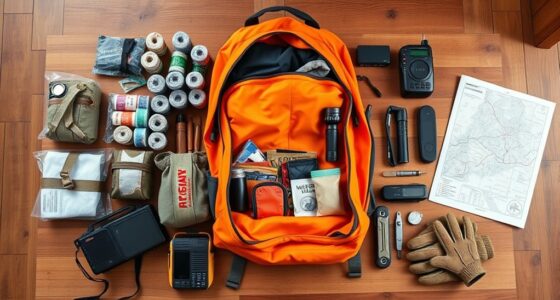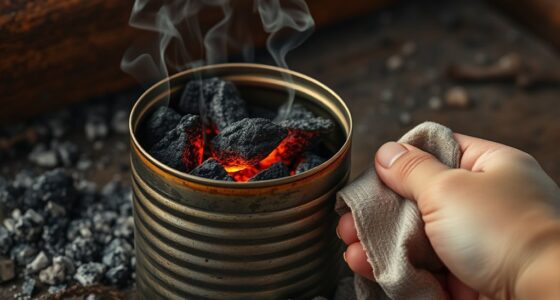If you or someone else gets bitten by a spider or snake, immediate action is crucial. First, call 911 for suspected venomous snake bites. Keep the victim calm and still to slow venom spread. For snake bites, wash the area, immobilize the limb, and avoid ice or tourniquets. Monitor symptoms for spider bites, especially from black widows or brown recluses, and cover the bite with a loose bandage. Always know your local venomous species and carry a basic emergency kit. Want to discover more essential tips and strategies to enhance your response?
Key Takeaways
- Call 911 immediately for suspected venomous snake bites and keep the victim calm and still to slow venom spread.
- Clean the bite area with soap and water, then cover it with a loose, dry bandage without applying ice or tourniquets.
- For spider bites, monitor symptoms closely, especially from black widows or recluses, and seek medical help if redness or swelling occurs.
- Familiarize yourself with local venomous species to enhance prevention and response strategies during outdoor activities.
- Keep an emergency kit with antiseptic wipes, pressure bandages, and a list of emergency contacts for quick access.
Introduction
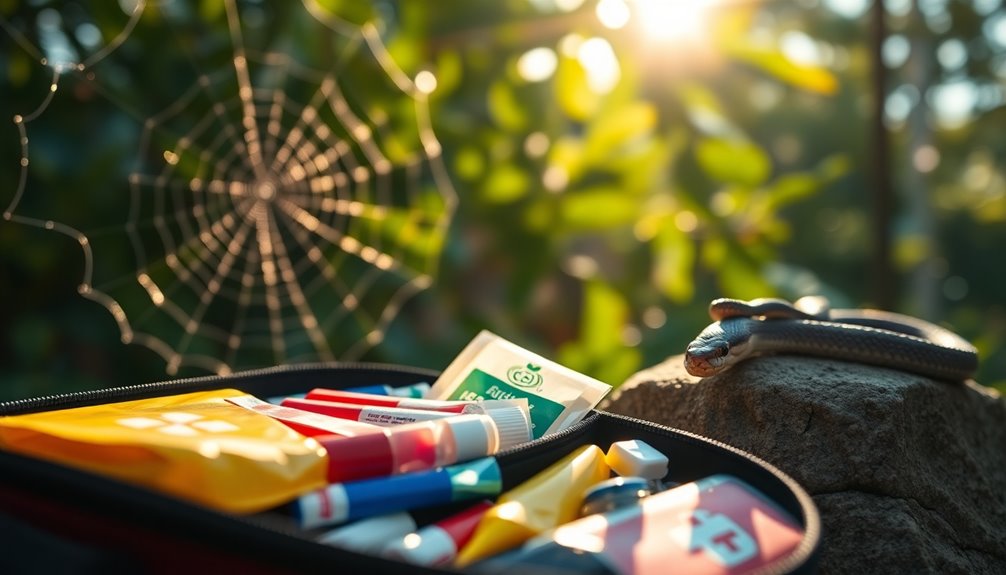
When it comes to spider and snake bites, you need to recognize that some can be life-threatening.
Immediate action can make a crucial difference, so knowing what to do is essential.
Being prepared not only helps you respond effectively but can also save lives.
Bites Can Be Life-Threatening
Spider and snake bites can escalate quickly into serious medical emergencies if left untreated.
While fatalities from venomous snakes in the U.S. are rare, averaging only 5-10 per year, the symptoms can be severe. Intense pain, swelling, and systemic reactions can occur, especially with bites from black widow and brown recluse spiders.
A black widow bite may cause muscle spasms, while a brown recluse bite can lead to painful skin lesions. It's crucial to seek immediate medical attention, as timely First Aid can significantly improve recovery outcomes.
Knowing your local venomous species and their dangers is vital for effective prevention and prompt emergency response. Don't underestimate the seriousness of these bites; your life could depend on it.
Immediate Action Saves Lives
Swift action is crucial when dealing with spider or snake bites. If you suspect a venomous snake bite, call 911 immediately to get medical help. Timely intervention can be lifesaving.
For spider bites, especially from venomous species like the black widow or brown recluse, recognizing symptoms early can significantly reduce severe complications. Keep the bite victim calm and immobile to slow the spread of venom; reassure them until assistance arrives.
Clean the bite area with soap and water, then cover it with a loose, dry bandage to prevent infection. Being aware of local venomous species and their symptoms enhances your preparedness, enabling you to respond quickly to bites that could lead to serious health issues.
Bite Identification Is Crucial

Identifying the source of a bite is crucial for effective treatment. Different snakes and spiders require varied first aid responses.
In the U.S., primary venomous snakes include copperheads, cottonmouths, rattlesnakes, and coral snakes. You can recognize copperheads by their hourglass patterns, while cottonmouths reveal white interiors in their mouths when threatened. Rattlesnakes have distinctive rattles at their tail tips, and coral snakes feature black, yellow, and red rings.
For spiders, brown recluse spiders have six eyes arranged in pairs, whereas black widows are identifiable by their red hourglass marking.
Timely and accurate identification significantly influences treatment decisions and the urgency of seeking medical care, especially in cases of venomous snake bites. Knowing what bit you could save your life.
Preparedness for Venomous Encounters
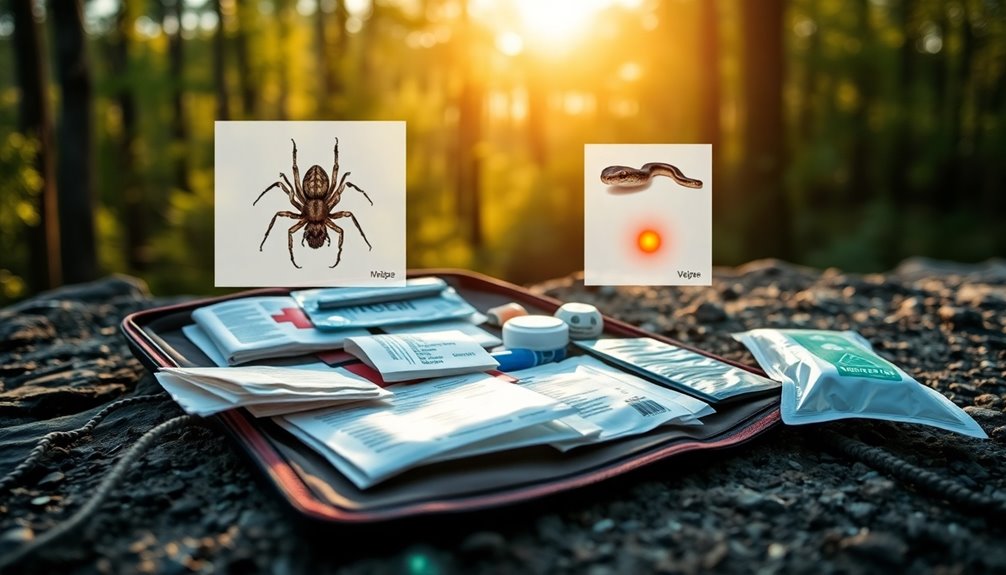
Being prepared for encounters with venomous snakes and spiders can significantly reduce the risk of serious injuries.
Understanding your environment and knowing the local species helps you stay alert while enjoying outdoor activities.
Plus, having a solid emergency response plan is essential; it could save a life in case of a bite.
Emergency Response Reduces Fatalities
Understanding the risks associated with venomous encounters can significantly reduce fatalities in emergency situations. Immediate medical attention is crucial for venomous bites, as timely intervention can prevent complications and save lives.
Familiarizing yourself with local species, like rattlesnakes and black widow spiders, enhances your preparedness and helps you recognize potential threats. If bitten, keep the affected limb still and at or below heart level to slow the spread of venom. Applying a pressure-immobilization bandage can also mitigate effects until you reach medical care.
Educating yourself and your community on first aid procedures and local wildlife habits empowers everyone to act quickly in emergencies, ultimately reducing the risk of fatalities from venomous encounters.
Environmental Awareness Is Essential
Awareness of your surroundings plays a critical role in preventing encounters with venomous snakes and spiders.
By maintaining short grass and steering clear of tall, undisturbed areas, you can significantly reduce the chances of a venomous snakebite, as these creatures prefer such habitats for hunting.
When you venture outdoors, wear sturdy shoes and long pants to protect yourself from potential bites.
Familiarizing yourself with local venomous species, like rattlesnakes and black widow spiders, enables you to identify threats and react accordingly.
Also, understanding spiders' hiding habits, particularly in dark, dry spaces, helps you avoid unwanted encounters.
With climate change altering wildlife habitats, enhancing your environmental awareness is vital for adapting to increasing risks of venomous encounters.
Emergency Kit Essentials
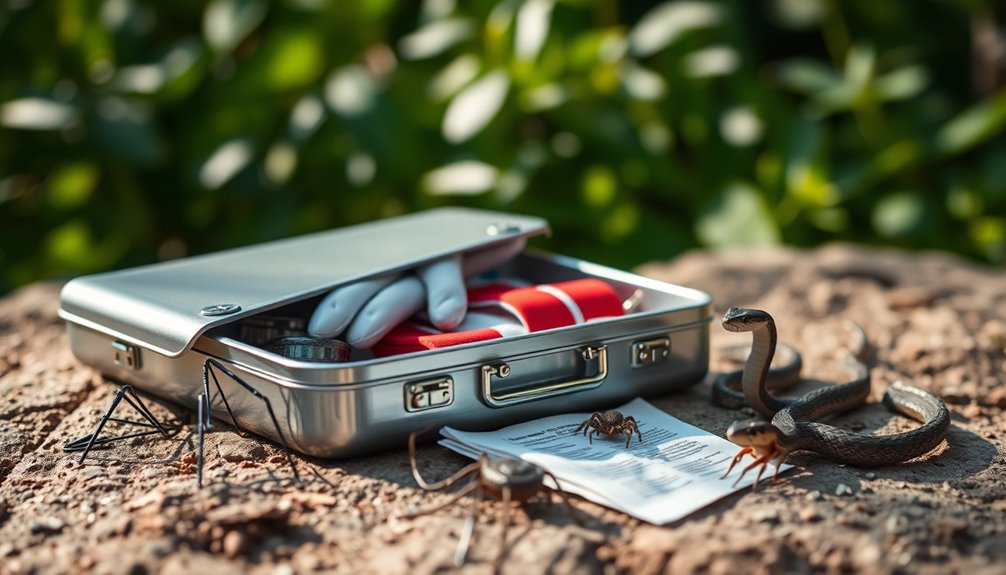
When preparing for potential emergencies involving snake and spider bites, having an effective emergency kit is crucial.
Start by including a pressure bandage for immobilization and a clean, dry dressing to cover the bite area. Antiseptic wipes or soap should also be in your kit to clean the bite site and prevent infection.
Don't forget a pair of sturdy gloves to protect yourself while administering first aid. Additionally, keep a list of emergency contacts, including local poison control and nearby medical facilities, for quick access.
It's wise to carry a first aid manual with specific guidelines for treating snake and spider bites to ensure you respond appropriately in emergencies.
These emergency kit essentials could save a life.
First Aid App Download
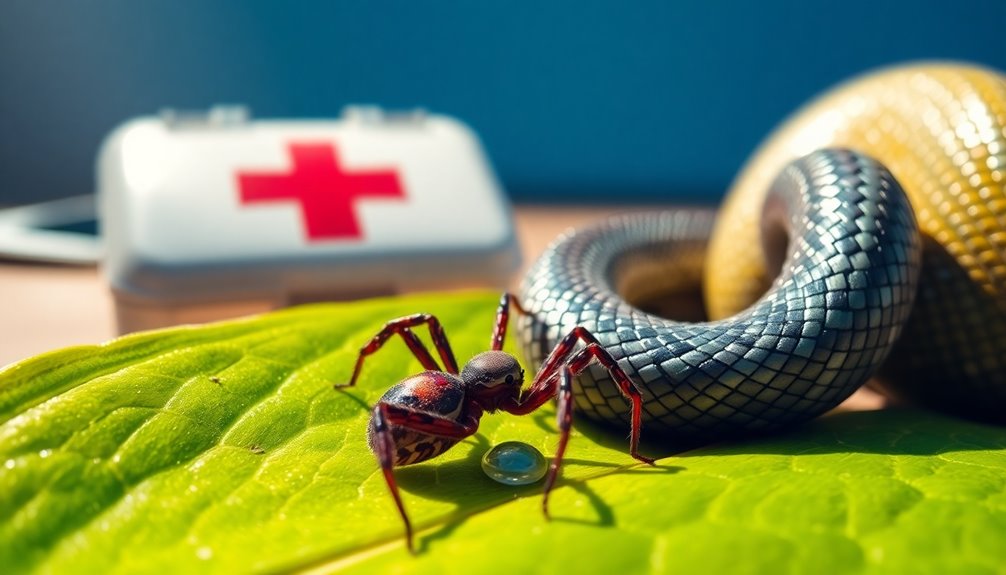
An effective emergency kit is just the start of being prepared for snake and spider bites. A first aid app download can be a game-changer in emergencies.
These apps provide quick access to essential information on managing bites, including specific first aid protocols and emergency contact numbers. If you're bitten by a snake, having an app handy means you can quickly check symptoms and determine the severity of the bite.
Many apps offer step-by-step guides for immediate response actions, helping you stay calm and focused. They also educate you on identifying local venomous species, boosting your awareness.
Regular updates keep you informed about new guidelines, ensuring you're always prepared with the best practices for treating bites.
Emergency Kit Must-Haves
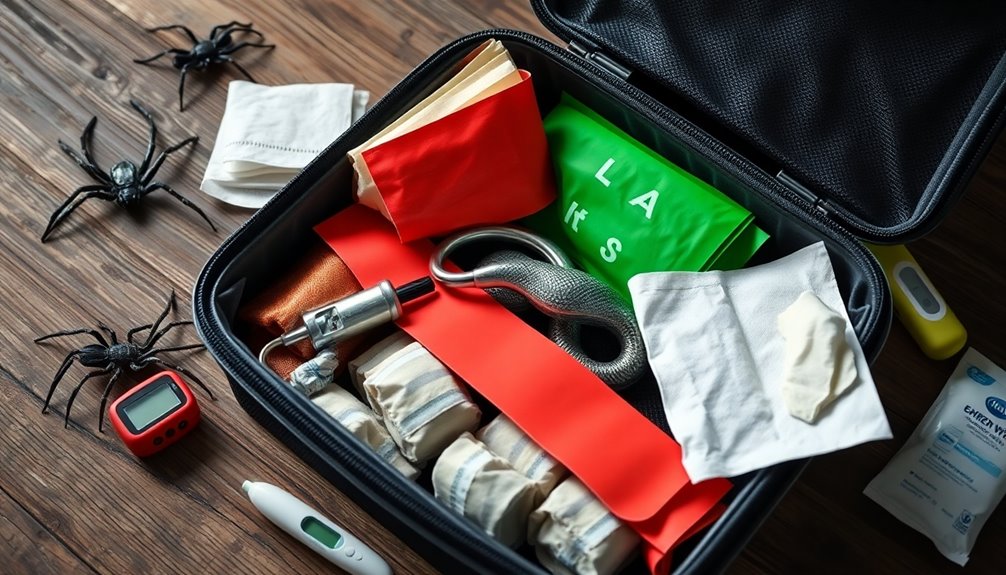
Having a well-stocked emergency kit can make a significant difference when dealing with snake and spider bites.
Start by including a pressure bandage to help immobilize the affected limb and slow venom spread. Antiseptic wipes are essential for cleaning the bite area, while sturdy gloves protect you from further injury or contamination.
Don't forget a pair of scissors; they're crucial for quickly removing constrictive items like jewelry or clothing to accommodate swelling. A first aid manual or quick reference guide will help you treat venomous bites and identify local species.
Lastly, always keep a mobile phone or two-way radio in your emergency kit for immediate access to emergency services.
Preparedness is key—make sure you have these must-haves ready.
Identifying Venomous Species Accurately
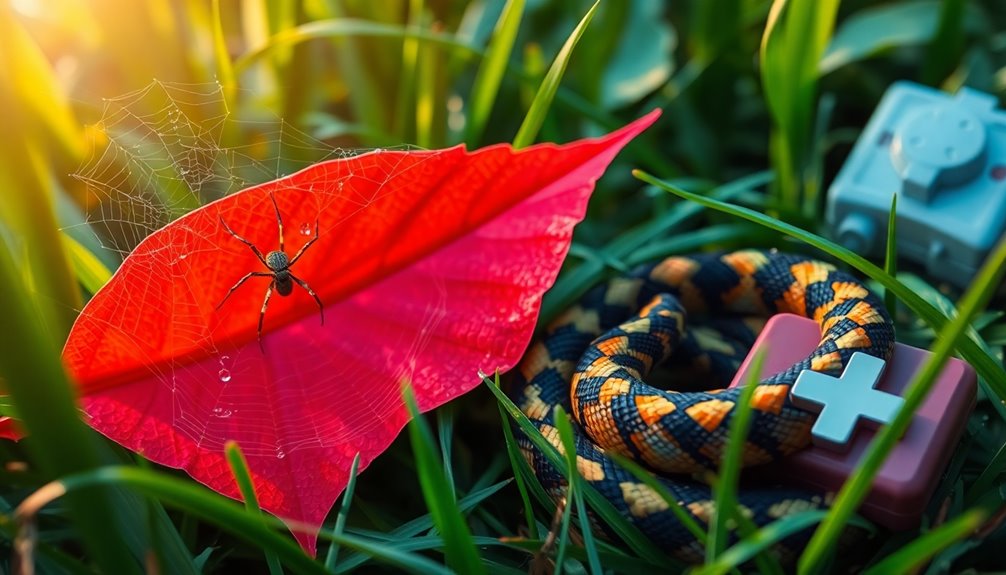
To stay safe in Texas, it's crucial to identify venomous species accurately.
Know the specific traits of snakes like the rattlesnake's rattle or the copperhead's hourglass pattern, and familiarize yourself with spiders like the black widow's red mark.
This knowledge can help you avoid dangerous encounters and respond effectively if a bite occurs.
Common Venomous Species Identification
Identifying venomous species accurately is crucial for safety, especially in areas like Texas where several dangerous snakes and spiders reside.
You should be aware that common venomous snakes include rattlesnakes, cottonmouths, copperheads, and coral snakes, with only 10% of Texas's 105 native species being venomous.
Rattlesnakes have distinctive rattles at their tails, while copperheads feature hourglass patterns on their skin.
Cottonmouths are typically found near water and reveal a white interior in their mouths when threatened.
Coral snakes can be identified by their unique black, yellow, and red ring pattern.
Among spiders, the black widow boasts a glossy black body with a red hourglass marking, while the brown recluse has six eyes and a violin-shaped marking on its back.
Species-Specific Identification Techniques
When you're outdoors, knowing how to identify venomous species can make a significant difference in your safety.
For example, if you're bitten by a snake, recognizing whether it's a copperhead, cottonmouth, or rattlesnake is crucial. Copperheads have hourglass patterns and are often found in urban areas, while cottonmouths reveal a white mouth interior when threatened, typically near water.
Rattlesnakes can be identified by their distinctive rattles. Coral snakes, with their black, yellow, and red rings, are slender and have round pupils.
If you encounter spiders, brown recluse spiders have six eyes and a violin marking, whereas black widows boast glossy black bodies with a red hourglass marking.
Knowing these traits helps you assess risks and stay safe outdoors.
Survivor Stories of Bites
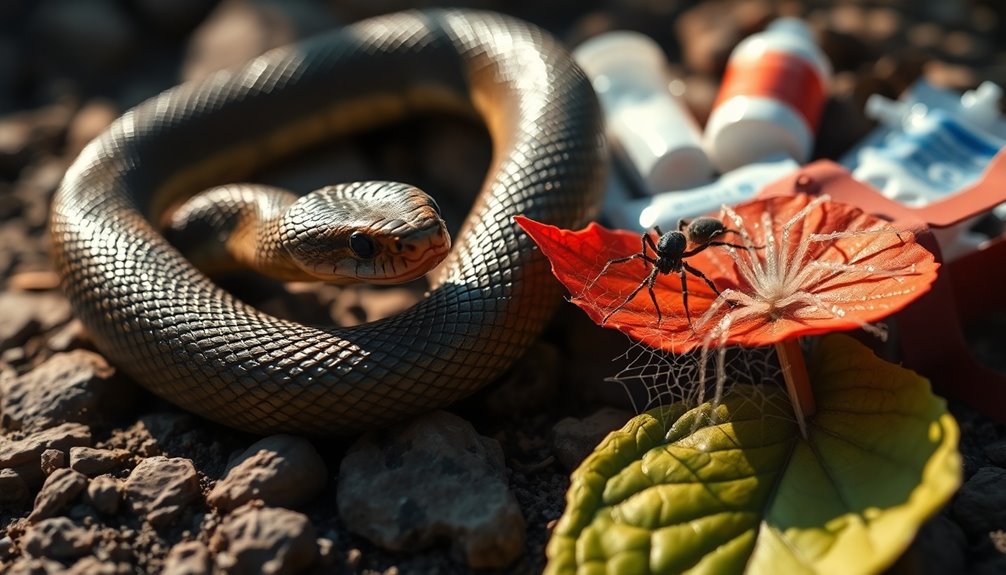
Survivor stories of spider and snake bites reveal the critical moments that can mean the difference between a harrowing experience and a swift recovery.
Many individuals emphasize staying calm and still after bites, which helps slow venom spread and improves treatment outcomes. Quick recognition of the bite source often leads to more effective medical care, especially when survivors can identify the species.
Immediate medical attention, including antivenom for snake bites, plays a crucial role in recovery, reducing symptom severity. Awareness of local spider species can also aid in prompt treatment.
These personal accounts underline the importance of education on first aid measures—those familiar with proper responses are more likely to act quickly and effectively, so always seek emergency help when needed.
Conclusion
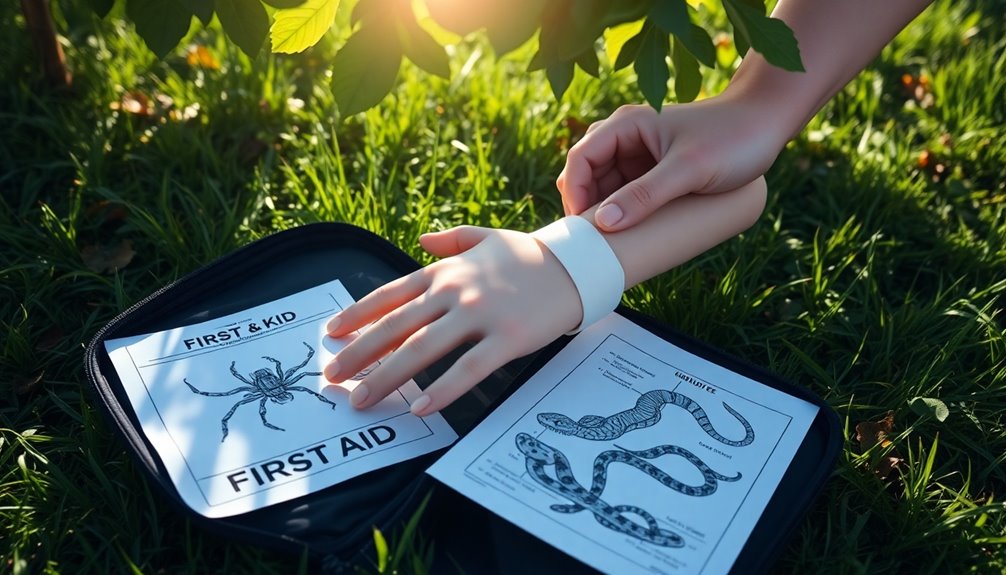
In conclusion, understanding the critical steps to take after a spider or snake bite can make all the difference in your recovery. Immediate medical attention is vital, as timely intervention significantly reduces the risk of complications.
For snake bites, wash the bite area, immobilize the limb, and call 911 without delay. Avoid using tourniquets or applying ice.
With spider bites, especially from black widows or brown recluses, monitor for symptoms like redness and swelling, and seek medical evaluation promptly, as these can indicate an allergic reaction.
Knowledge of local venomous species enhances your safety, allowing you to prevent bites altogether. Educating yourself on first aid procedures can save lives and improve outcomes in emergencies.
Stay informed, stay safe.
Additional Resources
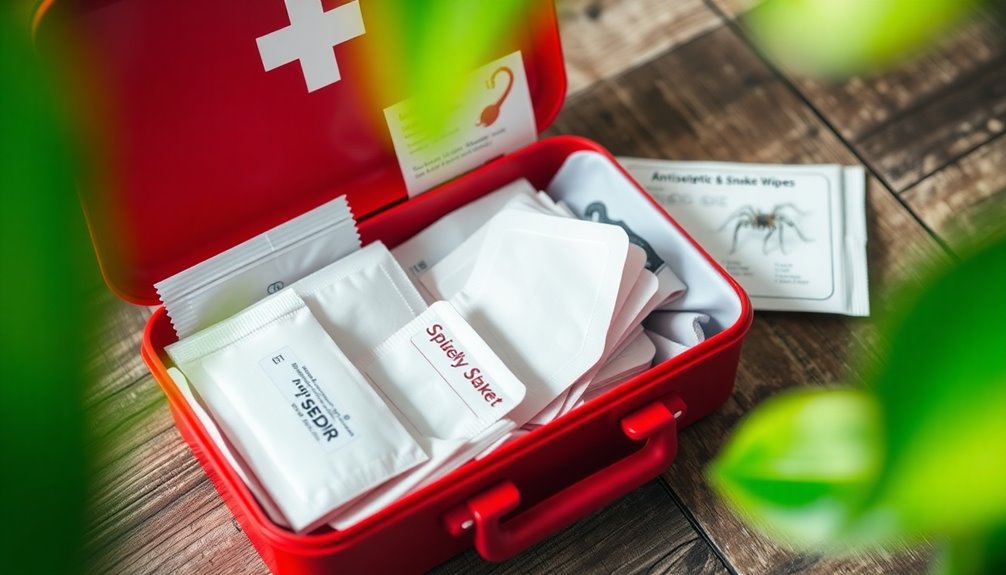
Accessing the right resources is crucial for effectively responding to spider and snake bites. The American Red Cross offers courses on first aid, CPR, and emergency response, which can prepare you for such incidents.
Local wildlife agencies and health departments provide educational materials that help you identify venomous species in your area. Community programs can also boost your awareness of wildlife safety, reducing fear around snakes and spiders.
For immediate information, consider using online resources from the CDC and WHO, which include guidelines on prevention and treatment.
If you encounter a red back spider, remember that applying ice can help alleviate pain. Additionally, understanding signs of illness in pets can enhance your overall preparedness for emergencies.
Lastly, don't hesitate to contact poison control centers for real-time assistance and advice following a bite.
Frequently Asked Questions
What Is the First Thing You Should Do if Bitten by a Snake or Spider?
If you get bitten by a snake or spider, the first thing you should do is wash the bite area with soap and water. This helps reduce the risk of infection.
After that, don't hesitate to call 911 or your local emergency number for immediate medical help.
Keep the affected limb still and at or below heart level, and remove any tight clothing or jewelry to allow for swelling.
Stay calm and still to avoid spreading venom.
What Are the First 5 Steps in First Aid for a Spider Bite?
If you find yourself bitten by a spider, start by keeping the victim calm and still to slow down venom spread.
Next, apply an ice pack to the bite to help with pain and swelling.
Remove any tight clothing or jewelry around the area to prevent constriction.
Keep a close eye on symptoms, and if you notice any redness, swelling, or spasms, get medical help immediately.
Prompt action is key!
How Can You Save Life From a Snake Bite?
If someone gets bitten by a snake, your first step is to call 911 or your local emergency number right away.
Keep the victim calm and still, positioning the affected limb at heart level or lower. Remove tight clothing or jewelry near the bite site to allow for swelling.
Avoid ice or tourniquets, and don't cut the bite. Gently wash the area, cover it, and monitor their symptoms until help arrives.
What Is the First Aid Intervention for a Snake Bite?
When you're dealing with a snake bite, your first step is to call 911 or your local emergency number right away.
Keep the victim calm and still, keeping the affected limb at or below heart level.
Clean the bite area gently and remove tight clothing or jewelry.
Cover the wound with a clean dressing, but don't apply ice or tourniquets.
Avoid caffeine, alcohol, and pain relievers, as these can complicate medical care.

